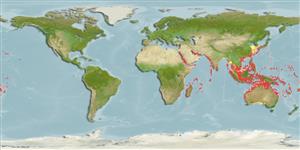Actinopterygii (ray-finned fishes) >
Perciformes (Perch-likes) >
Carangidae (Jacks and pompanos) > Caranginae
Environment / Climate / Range
Ecology
Marine; brackish; reef-associated; depth range 1 - 80 m (Ref. 58302). Tropical, preferred 27°C (Ref. 107945); 35°N - 35°S, 32°E - 169°W
Indo-Pacific: Red Sea and the east coast of Africa to the Hawaiian Islands and Samoa, north to Japan (Ref. 559), south to the Arafura Sea (Ref. 9819) and northern Australia.
Length at first maturity / Size / Weight / Age
Maturity: Lm ?, range 17 - ? cm
Max length : 30.0 cm TL male/unsexed; (Ref. 30573); common length : 26.0 cm TL male/unsexed; (Ref. 30573)
Adults inhabit mangroves and coastal bays. They form schools (Ref. 4887), or singly (Ref. 48635). Pelagic (Ref. 58302). Mainly diurnal. They feed on cephalopods, crustaceans and planktonic invertebrates such as copepods (Ref. 5213, 90102). Fast swimming in midwater in pursuit of zooplankton (Ref. 48635).
Paxton, J.R., D.F. Hoese, G.R. Allen and J.E. Hanley, 1989. Pisces. Petromyzontidae to Carangidae. Zoological Catalogue of Australia, Vol. 7. Australian Government Publishing Service, Canberra, 665 p. (Ref. 7300)
IUCN Red List Status (Ref. 115185)
CITES (Ref. 94142)
Not Evaluated
Threat to humans
Harmless
Human uses
Fisheries: minor commercial; gamefish: yes
More information
ReferencesAquacultureAquaculture profileStrainsGeneticsAllele frequenciesHeritabilityDiseasesProcessingMass conversion
Tools
Special reports
Download XML
Internet sources
